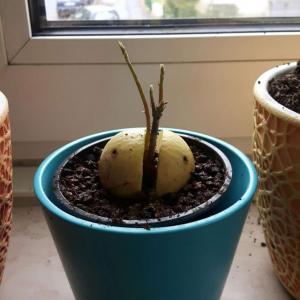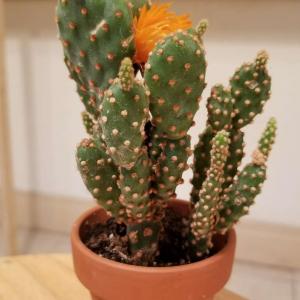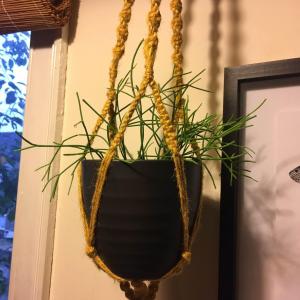cclecombe
2017年10月17日

Took a couple of heads off my Sedum Burrito to grow a second one so for now they're callousing over the next few days before they go into soil


2
0
成长记
Estefania Pereira
2017年10月16日

perks is a weird one for me too, i think i should add more soil to it, its a pretty weird one but im hoping it will grow nicely, dont know if there are any changes from when i bought it though




0
0
文章
Dummer. ゛☀
2017年10月08日

Cannas are lush tropical plants with huge leaves and vibrant blossoms on tall stalks. Many varieties have multicolored and patterned leaves, making them a season-long focal point.
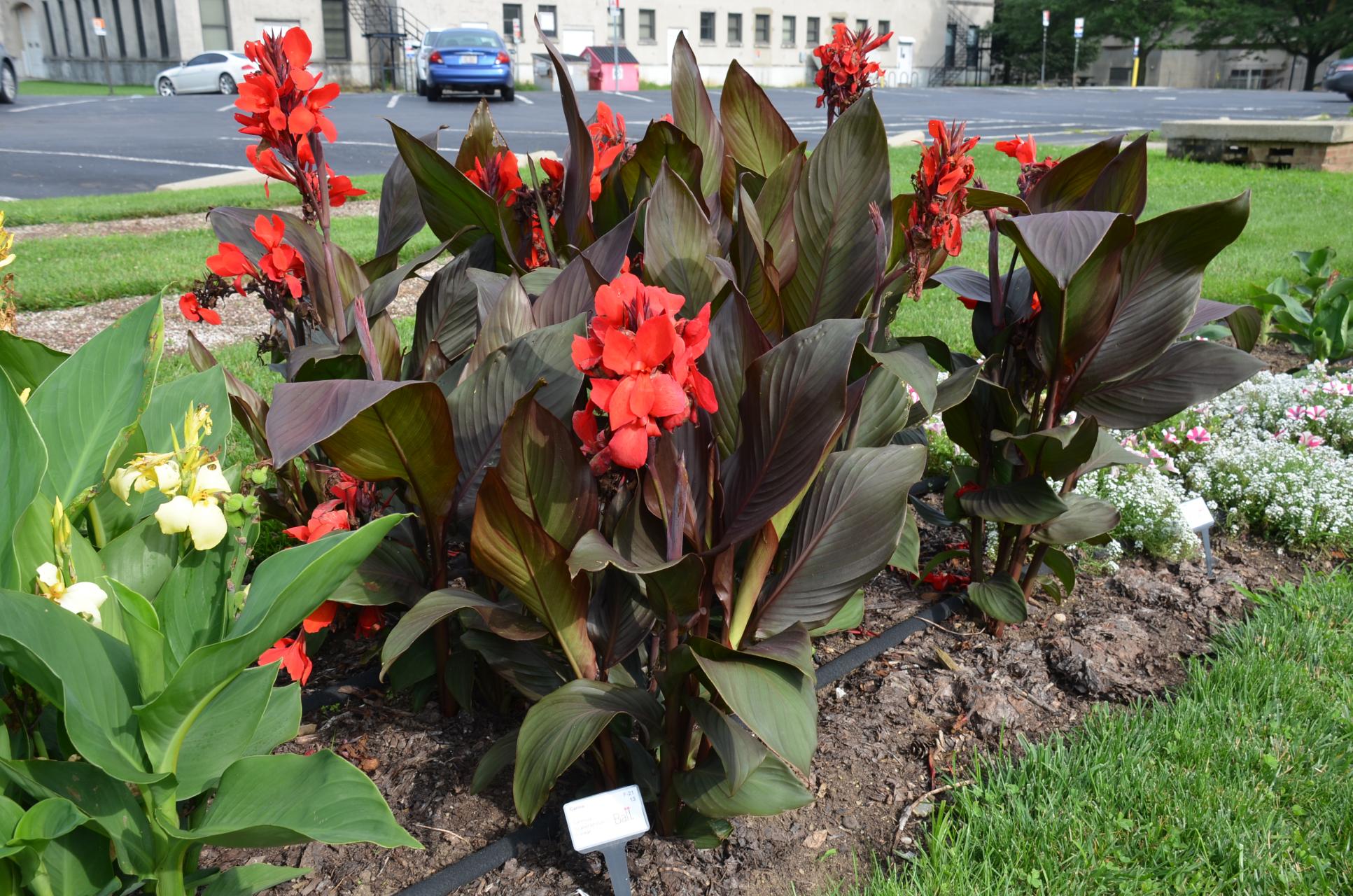
Choosing a site to grow cannas
Select a site with full sun and moist soil. Tall varieties should be sheltered from strong winds.
Special features of cannas
Unusual foliage

Planting Instructions
Plant canna rhizomes in spring after all danger of frost has passed and the soil has warmed. Prepare the garden bed by using a garden fork or tiller to loosen the soil to a depth of 12 to 15 inches, then mix in a 2- to 4-inch layer of compost. Dig a hole 4 to 6 inches deep. Set the rhizome horizontally in the hole, cover it with soil, and press firmly. Space rhizomes 1 to 4 feet apart, depending on the variety. Water thoroughly. In regions with short summers, start rhizomes indoors by potting up and placing them in a warm, sunny location.
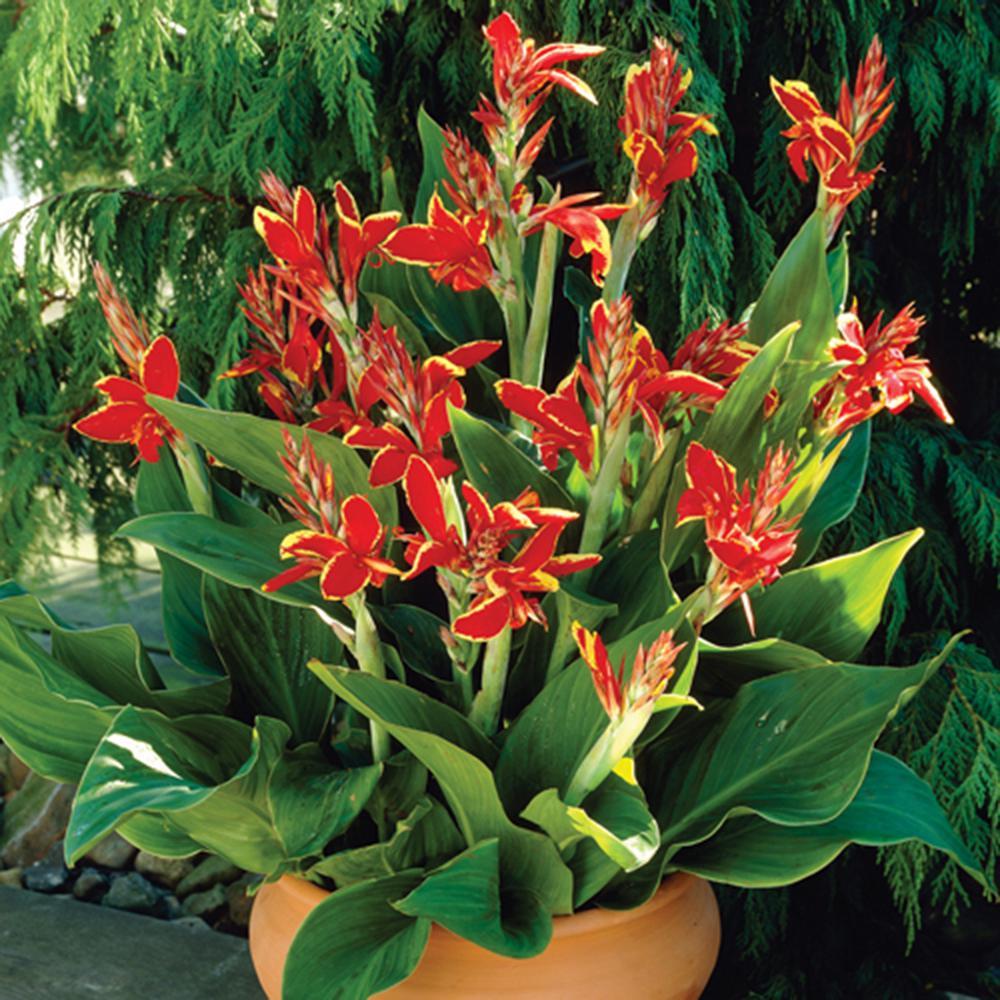
Ongoing Care
Apply a 2- to 4-inch layer of mulch around cannas to retain moisture and control weeds. Cannas prefer consistently moist soil, so water plants during the summer if rainfall is less than 1 inch per week, and water container-grown plants frequently to keep soil moist. Stake tall varieties to keep them upright. Remove flowers as they fade. In autumn, after frost kills the foliage, cut plants back to 6 inches tall. Carefully lift each clump of rhizomes and put them in a plastic-lined box filled with perlite or peat moss, spacing them so that none are touching. Store boxes off the floor in a dry area at 45 to 55 degrees F. Replant in the spring.

Choosing a site to grow cannas
Select a site with full sun and moist soil. Tall varieties should be sheltered from strong winds.
Special features of cannas
Unusual foliage

Planting Instructions
Plant canna rhizomes in spring after all danger of frost has passed and the soil has warmed. Prepare the garden bed by using a garden fork or tiller to loosen the soil to a depth of 12 to 15 inches, then mix in a 2- to 4-inch layer of compost. Dig a hole 4 to 6 inches deep. Set the rhizome horizontally in the hole, cover it with soil, and press firmly. Space rhizomes 1 to 4 feet apart, depending on the variety. Water thoroughly. In regions with short summers, start rhizomes indoors by potting up and placing them in a warm, sunny location.

Ongoing Care
Apply a 2- to 4-inch layer of mulch around cannas to retain moisture and control weeds. Cannas prefer consistently moist soil, so water plants during the summer if rainfall is less than 1 inch per week, and water container-grown plants frequently to keep soil moist. Stake tall varieties to keep them upright. Remove flowers as they fade. In autumn, after frost kills the foliage, cut plants back to 6 inches tall. Carefully lift each clump of rhizomes and put them in a plastic-lined box filled with perlite or peat moss, spacing them so that none are touching. Store boxes off the floor in a dry area at 45 to 55 degrees F. Replant in the spring.
2
2
成长记
cclecombe
2017年10月08日

I'm so upset about this guy! He was doing so well! I think now winter is here, its taking a lot longer for the soil to dry out, especially in the bathroom, so I've moved this to out kithen which is a but warmer!


0
0
hege:I think your gollums are Crassula ovata convoluta
成长记
cclecombe
2017年10月01日

Shes doing okay so far! My friend bought one at the same time but unfortunately with her flat being a bit damp this time of year it kinda trned to mush 😞 I've not watered it since I brought it home as the soil was moist already, but she seems quite happy with that!


1
0
采元气少女✨:beautiful!
文章
Dummer. ゛☀
2017年09月30日

Jade Plant (Crassula ovata) is a succulent native to South Africa, now a familiar garden and houseplant around the world, largely due to how easy it is to care for. It is tolerant of poor sandy soil, prefers to be root bound in a pot and doesn’t need too much watering. With minimal care, these plants can live for decades. Only in regions where the temperatures are extreme, do you even have to worry about the temperature in which to keep your Jade Plant. Jade Plants actually need some exposure to cooler temperatures in the winter to thrive.
Hardy Zones
Jade Plant is considered hardy in U.S. Department of Agriculture plant hardiness zones 10 and 11, with temperature ranges of 30 to 50 degrees Fahrenheit (-1 to 10 degrees Celsius) in the winter. Throughout much of the West Coast and southern states, the Jade Plant can live outdoors even in the winter.
Best Temperatures
Jade Plants will tolerate lower temperatures and even prefer the lower temperatures of about 45 to 55 degrees Fahrenheit (7 to 13 degrees Celsius) in the winter.
Cold Temperature Damage
If exposed to frost or low temperatures for too long, your Jade Plant may appear limp. If this occurs, you may just need to wait and see if the plant revives. Cut back any stems that turn black or appear rotted. Don’t be tempted to overwater the plant to revive it. Let the soil dry out before watering. Bring it indoors into a room that gets good ambient sunlight.
Protection from Cold Temperatures
If you live in an area where temperatures regularly drop below 45 degrees Fahrenheit (7 degrees Celsius), you should keep your Jade Plant in a pot and bring it indoors for the winter. You can move it back outdoors in the spring when temperatures are regularly above 45 degrees Fahrenheit (7 degrees Celsius). If you live in a region where temperatures only sometimes drop too low for your Jade Plant, then it will probably be fine outdoors with some protection from frost, such as bringing it onto a covered patio, covering it with cloth, or stringing Christmas lights onto the plant.

Hardy Zones
Jade Plant is considered hardy in U.S. Department of Agriculture plant hardiness zones 10 and 11, with temperature ranges of 30 to 50 degrees Fahrenheit (-1 to 10 degrees Celsius) in the winter. Throughout much of the West Coast and southern states, the Jade Plant can live outdoors even in the winter.

Best Temperatures
Jade Plants will tolerate lower temperatures and even prefer the lower temperatures of about 45 to 55 degrees Fahrenheit (7 to 13 degrees Celsius) in the winter.

Cold Temperature Damage
If exposed to frost or low temperatures for too long, your Jade Plant may appear limp. If this occurs, you may just need to wait and see if the plant revives. Cut back any stems that turn black or appear rotted. Don’t be tempted to overwater the plant to revive it. Let the soil dry out before watering. Bring it indoors into a room that gets good ambient sunlight.

Protection from Cold Temperatures
If you live in an area where temperatures regularly drop below 45 degrees Fahrenheit (7 degrees Celsius), you should keep your Jade Plant in a pot and bring it indoors for the winter. You can move it back outdoors in the spring when temperatures are regularly above 45 degrees Fahrenheit (7 degrees Celsius). If you live in a region where temperatures only sometimes drop too low for your Jade Plant, then it will probably be fine outdoors with some protection from frost, such as bringing it onto a covered patio, covering it with cloth, or stringing Christmas lights onto the plant.
0
0
文章
Miss Chen
2017年09月29日

Tulips (Tulipa spp.) poking their heads out of the soil is one of the first signs that spring has arrived, and the brightly colored blooms don't disappoint in the weeks that follow. Hardy in U.S. Department of Agriculture plant hardiness zones 4 through 10, most tulips are perennial, and they'll bloom again next spring if you take proper care of them once they're done blooming this year.

As Blooms Fade
Once the tulip blooms have started to wilt and droop, gently pluck the remaining petals from the stem. If you prefer, cut off the dead flowers, as well as 1 to 2 inches of the stem. Don't, however, pull or snip off the plants' leaves. Allow the leaves to die back on their own, because even though the flower is gone for the year, the roots of the plant still rely on photosynthesis from the leaves to feed the plant. Deadheading the blooms prevents the plant from developing seeds and directs the plant's energy back into the bulb. To prevent disease, always use disinfected pruning tools when cutting any portion of the tulip.
After the Stems Turn Yellow
If you don't like the way the dying leaves and stems look, plant other flowers or foliage around the tulips to disguise the unsightliness. After the leaves have turned yellow and died back on their own, gently remove them from the stem. If the stems have wilted or turned yellow or brown, snip them off at ground level. Don't be tempted to do this too soon, however, or it could inhibit the tulips from returning next year. In cooler areas that experience frost and snow, cover the tulip bed with 2 to 4 inches of organic mulch like straw to protect the bulbs over winter. Use the same amount of mulch in warmer zones to preserve moisture in the soil.
Water Properly
As long as the stems of the tulips are green, you need to water them regularly. Until the stem dies, the bulb is storing up energy for the winter and water is necessary for this process. While there isn't a specific guideline regarding how much to water the tulips once they've bloomed, it's a good idea to give them a thorough watering every few days, especially if your area is experiencing a dry spell and make sure to continue watering during dry weather conditions throughout fall. Apply enough water to saturate the soil to a depth of approximately 6 inches to reach the tulip roots.

Divide and Fertilize
Older plants might need to be divided after they bloom to encourage them to return the next spring and to alleviate overcrowding that creates smaller bloom size. In warm areas of USDA zones 8 through 10, tulip bulbs require lifting and storing for six to eight weeks in the refrigerator inside a paper bag. Don't store the bulbs next to ripening fruit where the ethylene gas destroys the flower bud developing inside the bulb. When lifting and replanting, dig up the older bulbs and remove the largest "daughter" bulb. Replant each daughter 6 to 8 inches deep and spacing each bulb 5 inches apart, keeping in mind that tulips thrive in full sun. Fertilizing is usually recommended while the tulips are blooming, but you should also plan to fertilize if you divide the bulbs after they bloom. When blooming starts to occur, incorporate 2 pounds of 5-10-5 or 5-10-10 fertilizer per 100 square feet into the soil. Incorporate the fertilizer into the top inch of soil and wash it off any portion of the tulip it touches. The same type of balanced fertilizer can be applied right after you divide and replant the bulbs. When adding fertilizer to the planting hole, be sure to cover the fertilizer with approximately 1 inch of soil and do not allow the bulb to have direct contact with the fertilizer so the bulb isn't damaged or burned.

As Blooms Fade
Once the tulip blooms have started to wilt and droop, gently pluck the remaining petals from the stem. If you prefer, cut off the dead flowers, as well as 1 to 2 inches of the stem. Don't, however, pull or snip off the plants' leaves. Allow the leaves to die back on their own, because even though the flower is gone for the year, the roots of the plant still rely on photosynthesis from the leaves to feed the plant. Deadheading the blooms prevents the plant from developing seeds and directs the plant's energy back into the bulb. To prevent disease, always use disinfected pruning tools when cutting any portion of the tulip.
After the Stems Turn Yellow
If you don't like the way the dying leaves and stems look, plant other flowers or foliage around the tulips to disguise the unsightliness. After the leaves have turned yellow and died back on their own, gently remove them from the stem. If the stems have wilted or turned yellow or brown, snip them off at ground level. Don't be tempted to do this too soon, however, or it could inhibit the tulips from returning next year. In cooler areas that experience frost and snow, cover the tulip bed with 2 to 4 inches of organic mulch like straw to protect the bulbs over winter. Use the same amount of mulch in warmer zones to preserve moisture in the soil.
Water Properly
As long as the stems of the tulips are green, you need to water them regularly. Until the stem dies, the bulb is storing up energy for the winter and water is necessary for this process. While there isn't a specific guideline regarding how much to water the tulips once they've bloomed, it's a good idea to give them a thorough watering every few days, especially if your area is experiencing a dry spell and make sure to continue watering during dry weather conditions throughout fall. Apply enough water to saturate the soil to a depth of approximately 6 inches to reach the tulip roots.

Divide and Fertilize
Older plants might need to be divided after they bloom to encourage them to return the next spring and to alleviate overcrowding that creates smaller bloom size. In warm areas of USDA zones 8 through 10, tulip bulbs require lifting and storing for six to eight weeks in the refrigerator inside a paper bag. Don't store the bulbs next to ripening fruit where the ethylene gas destroys the flower bud developing inside the bulb. When lifting and replanting, dig up the older bulbs and remove the largest "daughter" bulb. Replant each daughter 6 to 8 inches deep and spacing each bulb 5 inches apart, keeping in mind that tulips thrive in full sun. Fertilizing is usually recommended while the tulips are blooming, but you should also plan to fertilize if you divide the bulbs after they bloom. When blooming starts to occur, incorporate 2 pounds of 5-10-5 or 5-10-10 fertilizer per 100 square feet into the soil. Incorporate the fertilizer into the top inch of soil and wash it off any portion of the tulip it touches. The same type of balanced fertilizer can be applied right after you divide and replant the bulbs. When adding fertilizer to the planting hole, be sure to cover the fertilizer with approximately 1 inch of soil and do not allow the bulb to have direct contact with the fertilizer so the bulb isn't damaged or burned.
0
0
文章
Dummer. ゛☀
2017年09月28日

Camellias are one of the most popular winter- and spring-flowering shrubs, providing a vivid splash of color when little else is in bloom. Most spring-flowering Camellias prefer neutral to acid soil (between pH 7 and pH 5) so those on chalky or alkaline soil will struggle.
When to Plant
The best time to plant them is spring, when you can see the flowers, or in autumn. If you buy one in winter, keep it somewhere sheltered and plant it in spring.
Where to Plant
Most Camellias we grow are raised from four species Camellia japonica, Camellia sasanqua. Camellia saluensis and Camillia reticulate. These are understorey plants found growing under trees near the brighter edges of woods and forests, so they want dappled light in your garden, preferably with overhead leafy shelter.
If you’re growing your Camellia in a container find it a sheltered position, ideally on a north or west-facing wall. This will ensure that the early flowers do not get browned by frost which can easily happen on an cold east-facing wall where morning sun causes a quick thaw. Southern walls are generally too warm and dry.
They need a well-drained position and they will die in water-logged ground due to the lack of oxygen in the soil. They like warm, not hot summers, with plenty of humidity.
Growing Camellias in Pots
Choose a large rugged pot, terracotta, wood or stone, and part fill with ericaceous compost and then add your plant and back fill so that the level of the pot is level with the soil. Water well, preferably with water taken from a water butt. If you do use tap water, which tends to be alkaline, allow it to stand for a morning first.
Re-pot every other year into fresh potting compost. In the intervening years remove the top 2 inches (5 cm) of compost and add fresh compost. You can re-pot back into the same pot if you trim off up to a third of the roots to make room for fresh potting compost, or go up into a larger pot. This regime will keep your Camellia happy.
Growing Camellias in the Ground
Camellias are fast-growing tap-rotted plants and the new growth can snap off in windy positions so staking is advisable for the first few years until the Camellia becomes bushy. They do tolerate windy conditions however, once established, and are often used as windbreaks in gardens where they thrive.
How to Plant
Dig a hole twice the size of the pot and prepare a mixture of leaf mold, garden compost and some animal manure. If this isn’t possible use a loam based compost and add a slow release fertilizer.
Take the plant out of the pot and loosen the root ball with your fingers.
Place the plant in the hole so that the top is level with the ground. Use a bamboo cane balanced on either side of the hole if you’re unsure.
Pruning
This is best done lightly in spring after flowering, in April and May, and this is good practice with all evergreens. However pruning is not necessary! Leave it alone unless it’s got too large.
Growing from Seed
In warm gardens Camellias can set large seeds of hazel nut size inside quince-like fruits. Remove the brown seeds and push them into a pot filled with compost and grit, ensuring they are just below the surface. They will produce a plant within two years for most.
Taking Cuttings
The best time to take cuttings is between August and September. Choose new growth and cut off a section of growth. Pull side shoots away so they have a heel – a ripped off end.
Pull off the lower leaves and trim the bottom of the cutting to get rid of the wispy end and dip the cuttings into hormone rooting powder. Push the cuttings into a mixture of peat and sand and keep them in a warm place out of full sun – ideally the temperature should be 65°F (15°C). Pot up rooted cuttings in the following spring.

When to Plant
The best time to plant them is spring, when you can see the flowers, or in autumn. If you buy one in winter, keep it somewhere sheltered and plant it in spring.
Where to Plant
Most Camellias we grow are raised from four species Camellia japonica, Camellia sasanqua. Camellia saluensis and Camillia reticulate. These are understorey plants found growing under trees near the brighter edges of woods and forests, so they want dappled light in your garden, preferably with overhead leafy shelter.

If you’re growing your Camellia in a container find it a sheltered position, ideally on a north or west-facing wall. This will ensure that the early flowers do not get browned by frost which can easily happen on an cold east-facing wall where morning sun causes a quick thaw. Southern walls are generally too warm and dry.
They need a well-drained position and they will die in water-logged ground due to the lack of oxygen in the soil. They like warm, not hot summers, with plenty of humidity.
Growing Camellias in Pots
Choose a large rugged pot, terracotta, wood or stone, and part fill with ericaceous compost and then add your plant and back fill so that the level of the pot is level with the soil. Water well, preferably with water taken from a water butt. If you do use tap water, which tends to be alkaline, allow it to stand for a morning first.

Re-pot every other year into fresh potting compost. In the intervening years remove the top 2 inches (5 cm) of compost and add fresh compost. You can re-pot back into the same pot if you trim off up to a third of the roots to make room for fresh potting compost, or go up into a larger pot. This regime will keep your Camellia happy.
Growing Camellias in the Ground
Camellias are fast-growing tap-rotted plants and the new growth can snap off in windy positions so staking is advisable for the first few years until the Camellia becomes bushy. They do tolerate windy conditions however, once established, and are often used as windbreaks in gardens where they thrive.

How to Plant
Dig a hole twice the size of the pot and prepare a mixture of leaf mold, garden compost and some animal manure. If this isn’t possible use a loam based compost and add a slow release fertilizer.
Take the plant out of the pot and loosen the root ball with your fingers.
Place the plant in the hole so that the top is level with the ground. Use a bamboo cane balanced on either side of the hole if you’re unsure.
Pruning
This is best done lightly in spring after flowering, in April and May, and this is good practice with all evergreens. However pruning is not necessary! Leave it alone unless it’s got too large.

Growing from Seed
In warm gardens Camellias can set large seeds of hazel nut size inside quince-like fruits. Remove the brown seeds and push them into a pot filled with compost and grit, ensuring they are just below the surface. They will produce a plant within two years for most.
Taking Cuttings
The best time to take cuttings is between August and September. Choose new growth and cut off a section of growth. Pull side shoots away so they have a heel – a ripped off end.

Pull off the lower leaves and trim the bottom of the cutting to get rid of the wispy end and dip the cuttings into hormone rooting powder. Push the cuttings into a mixture of peat and sand and keep them in a warm place out of full sun – ideally the temperature should be 65°F (15°C). Pot up rooted cuttings in the following spring.
0
0
求助
virginiagreen
2017年09月27日

I do not know what this bush is behind our house...I want to cut it back but would be helpful to know,what it before I do so. It lives in an open area, sunny and warm climate, sandy soil no additional care or watering...looks a bit straggly! It has some berries growing from it, height of plant 5'7" to top. When is a good time to cut this back a little? Thanks!
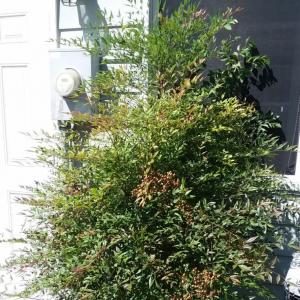

0
0
☆MintyHorizons☆:What colour(s) are the berries??
sunnyzou:name:Nandina domestica
文章
Dummer. ゛☀
2017年09月27日

Gloriosa Lilies (the genus Gloriosa), also known as Flame Lilies and Glory Lilies, thrive in fertile, well-drained soil in full to partial sun. Hardy in USDA plant hardiness zones 10 and 11, they can be overwintered successfully in zone 9 with winter mulch. In cooler areas, Gloriosa Lilies can be grown successfully during the summer and lifted and stored for the winter.
These exotic-looking lilies produce an abundance of yellow and red flowers with petals that curl backward to resemble a flash of brilliant flames. They can reach heights of 8 feet (2.4 m) and require a trellis or wall to climb. Although climbing lilies do not produce tendrils, the specialized leaves of the Gloriosa Lily cling to the trellis or other plant material, to pull the vine upward.
Growing Conditions
Select a location that receives six to eight hours of direct sunlight a day. In southern climates, a location that allows the vines to grow in full sun while the roots of the plant remain shaded is the best location for growing a Gloriosa Lily plant. Some protection from afternoon sun may be needed as well.
Prepare the soil by tilling to a depth of 8 inches (20 cm) and amending with generous amounts of organic matter such as peat moss, compost or well-rotted manure. Organic matter improves both drainage and aeration and provides a slow-release fertilizer to your Gloriosa Lilies.
Erect a 6-to 8-foot (1.8 to 2.4 m) trellis for your Gloriosa Lilies prior to planting. Check that it is secure and will not topple under the weight of the growing Gloriosa Lilies.
The ideal time for Gloriosa Lily planting is in the spring after the soil has warmed and all danger of frost has passed. Plant the Gloriosa Lily tubers approximately 3 to 4 inches (7.5 to 10 cm) from the trellis. Dig a hole to the depth of 2 to 4 inches (5 to 10 cm) and lay the tuber on its side in the hole.
Space the tubers 6 to 8 inches (15 to 20 cm) apart to allow room for the mature plants to grow. Cover the tubers and gently firm the soil down to remove air pockets and secure the tubers.
General Care
Water the newly planted tuber to saturate the soil to a depth of 2 to 3 inches (5 to 7.5 cm) to give your Gloriosa Lily a good start. Keep the soil evenly moist until shoots appear in two to three weeks. Reduce water to once or twice a week or whenever the soil feels dry an inch below the surface. Gloriosa Lilies typically require an inch of rain and week and need supplemental watering during dry periods.
Train the vines to climb the trellis by tying them to the trellis with soft plant ties, if necessary. Although Gloriosa Lilies cling to the trellis once established, they may need some help from you to get them started.
Fertilize Gloriosa Lilies every two weeks with water-soluble fertilizer designed for flowering plants. This provides the nutrients needed to promote healthy blooming.
Cut the vines back in the fall after they are killed by the frost. Tubers can be lifted and stored in moist peat moss in a cool, dark place for the winter and replanted in the spring.

These exotic-looking lilies produce an abundance of yellow and red flowers with petals that curl backward to resemble a flash of brilliant flames. They can reach heights of 8 feet (2.4 m) and require a trellis or wall to climb. Although climbing lilies do not produce tendrils, the specialized leaves of the Gloriosa Lily cling to the trellis or other plant material, to pull the vine upward.

Growing Conditions
Select a location that receives six to eight hours of direct sunlight a day. In southern climates, a location that allows the vines to grow in full sun while the roots of the plant remain shaded is the best location for growing a Gloriosa Lily plant. Some protection from afternoon sun may be needed as well.
Prepare the soil by tilling to a depth of 8 inches (20 cm) and amending with generous amounts of organic matter such as peat moss, compost or well-rotted manure. Organic matter improves both drainage and aeration and provides a slow-release fertilizer to your Gloriosa Lilies.
Erect a 6-to 8-foot (1.8 to 2.4 m) trellis for your Gloriosa Lilies prior to planting. Check that it is secure and will not topple under the weight of the growing Gloriosa Lilies.

The ideal time for Gloriosa Lily planting is in the spring after the soil has warmed and all danger of frost has passed. Plant the Gloriosa Lily tubers approximately 3 to 4 inches (7.5 to 10 cm) from the trellis. Dig a hole to the depth of 2 to 4 inches (5 to 10 cm) and lay the tuber on its side in the hole.
Space the tubers 6 to 8 inches (15 to 20 cm) apart to allow room for the mature plants to grow. Cover the tubers and gently firm the soil down to remove air pockets and secure the tubers.

General Care
Water the newly planted tuber to saturate the soil to a depth of 2 to 3 inches (5 to 7.5 cm) to give your Gloriosa Lily a good start. Keep the soil evenly moist until shoots appear in two to three weeks. Reduce water to once or twice a week or whenever the soil feels dry an inch below the surface. Gloriosa Lilies typically require an inch of rain and week and need supplemental watering during dry periods.
Train the vines to climb the trellis by tying them to the trellis with soft plant ties, if necessary. Although Gloriosa Lilies cling to the trellis once established, they may need some help from you to get them started.

Fertilize Gloriosa Lilies every two weeks with water-soluble fertilizer designed for flowering plants. This provides the nutrients needed to promote healthy blooming.
Cut the vines back in the fall after they are killed by the frost. Tubers can be lifted and stored in moist peat moss in a cool, dark place for the winter and replanted in the spring.
0
0
文章
Dummer. ゛☀
2017年09月27日

Rhododendron is an attractive, blooming bush in many landscapes and is fairly low maintenance when planted properly. Growing Rhododendron successfully requires the proper planting spot. Proper soil preparation is also necessary for the health of this acid loving plant.
Soil preparation is best accomplished in autumn before planting the Rhododendron in spring. When to plant it will depend on the USDA zone in which it grows. Growing Rhododendron is an exacting task, but with the right soil and location, it will provide an optimum performance.
Unlike many blooming plants, Rhododendron does not like full morning sun in winter and does best when planted in dappled shade on the north side of a building. Growing Rhododendrons are happiest in a location protected from the wind and not under eves of a building.
When to Plant
Plant the Rhododendron bush in spring when danger of frost has passed. Plant the bush high in properly prepared soil, as soggy and waterlogged roots are the main cause of plant failure in the landscape.
Rhododendron will likely be purchased as a containerized plant or a balled and burlapped specimen. The root ball should be soaked prior to planting. Moisture is required for proper care. Place the plant in a tub or bucket for a brief soaking, until air bubbles disappear. Plant the bush so that its crown is at the same level as in the pot.
Soil Preparation
Correct soil pH for the growing Rhododendrons is crucial. Between 4.5 and 5.5 on the pH scale is appropriate. A soil test is the best way to determine the pH of the soil and make amendments. Aluminum sulfate should be avoided when amending beds for growing Rhododendrons.
Rhododendron is best planted in groupings in prepared beds as opposed to individual planting holes. Caring for Rhododendrons will be simpler if they are planted is moisture retaining but well-draining, loamy fertile soil with the proper pH. A 50 percent ratio of organic matter is encouraged as a soil amendment, as it provides aeration and drainage and allows the bush to set higher.
General Care
Once properly located in the planting bed, water thoroughly and cover with an organic mulch which will break down to supply nutrients as it decomposes. A pine bark covering applied at 2 inches (5 cm) is thought to inhibit fungi that cause root rot. Do not mulch with peat moss, as it is difficult to rewet after it has dried out. Proper mulching will decrease the need for future care.
Rhododendron care includes a yearly fertilization which is best applied in fall, following a hard freeze or in early spring. Use a fertilizer for acid loving plants, such as organic cottonseed meal. The organic material you have worked into the soil previously will break down to provided some of the necessary nutrients.
Consistently moist soil is needed for proper care, but too much water creates problems for the growing Rhododendron. When leaves curl and twist, this indicates that water is needed immediately. The bush should not be allowed to go through the stress of wilting.
Growing healthy and long-blooming Rhododendrons starts with properly amended soil and planting in the correct location. These steps ensure minimal effort when caring for Rhododendrons. Once sited properly, the Rhododendron needs only adequate watering, pruning and deadheading of the flowers to encourage their abundant return.

Soil preparation is best accomplished in autumn before planting the Rhododendron in spring. When to plant it will depend on the USDA zone in which it grows. Growing Rhododendron is an exacting task, but with the right soil and location, it will provide an optimum performance.
Unlike many blooming plants, Rhododendron does not like full morning sun in winter and does best when planted in dappled shade on the north side of a building. Growing Rhododendrons are happiest in a location protected from the wind and not under eves of a building.

When to Plant
Plant the Rhododendron bush in spring when danger of frost has passed. Plant the bush high in properly prepared soil, as soggy and waterlogged roots are the main cause of plant failure in the landscape.
Rhododendron will likely be purchased as a containerized plant or a balled and burlapped specimen. The root ball should be soaked prior to planting. Moisture is required for proper care. Place the plant in a tub or bucket for a brief soaking, until air bubbles disappear. Plant the bush so that its crown is at the same level as in the pot.

Soil Preparation
Correct soil pH for the growing Rhododendrons is crucial. Between 4.5 and 5.5 on the pH scale is appropriate. A soil test is the best way to determine the pH of the soil and make amendments. Aluminum sulfate should be avoided when amending beds for growing Rhododendrons.
Rhododendron is best planted in groupings in prepared beds as opposed to individual planting holes. Caring for Rhododendrons will be simpler if they are planted is moisture retaining but well-draining, loamy fertile soil with the proper pH. A 50 percent ratio of organic matter is encouraged as a soil amendment, as it provides aeration and drainage and allows the bush to set higher.

General Care
Once properly located in the planting bed, water thoroughly and cover with an organic mulch which will break down to supply nutrients as it decomposes. A pine bark covering applied at 2 inches (5 cm) is thought to inhibit fungi that cause root rot. Do not mulch with peat moss, as it is difficult to rewet after it has dried out. Proper mulching will decrease the need for future care.

Rhododendron care includes a yearly fertilization which is best applied in fall, following a hard freeze or in early spring. Use a fertilizer for acid loving plants, such as organic cottonseed meal. The organic material you have worked into the soil previously will break down to provided some of the necessary nutrients.
Consistently moist soil is needed for proper care, but too much water creates problems for the growing Rhododendron. When leaves curl and twist, this indicates that water is needed immediately. The bush should not be allowed to go through the stress of wilting.

Growing healthy and long-blooming Rhododendrons starts with properly amended soil and planting in the correct location. These steps ensure minimal effort when caring for Rhododendrons. Once sited properly, the Rhododendron needs only adequate watering, pruning and deadheading of the flowers to encourage their abundant return.
0
1
文章
Dummer. ゛☀
2017年09月27日

One of the biggest and most popular problems with regard to gardening is under watering plants. Too little water for a plant means it is not getting the nutrients it needs from the water or the soil. So how can you tell plants have too little water? Keep reading to learn more.
Under Watering Plants in the Garden
Everyone is aware that there can be drought conditions. Throughout the summer, there are plenty of times when it doesn’t rain for weeks on end. During these times, you have to water your plants because without the necessary water, plants will dwarf, not produce or worse, die. Under watering plants is the worst thing you could do.
Planting your garden in an area that has trouble holding onto water, such as a sandy area, especially during the summer months, means you will have plants affected by not enough water. This is because the natural drainage of the area will leave too little water for a plant. Well drained soil is good because you do not want to overwater plants either, but there is such a thing as too well drained.
How Can You Tell Plants Have Too Little Water?
Plants affected by not enough water will have yellowing leaves or dried leaves toward the bottom of the plant. If you see this happening, you are probably under watering plants. Too little water for a plant makes it conserve what little water it has by keeping the stalk green and the roots moist, but the leaves will turn yellow and wilt, eventually drying up.
Plants affected by not enough water will also start showing some root at the surface. The ground around the plants will be cracked, and you can be assured that your plant roots are not getting the moisture or nutrients they need to grow properly – especially container grown plants. Make sure you water your plants so that they do not have difficulty producing the fruits and vegetables you are attempting to achieve.
Finally, too little water for a plant means that the plant will eventually die. If you want to make sure your plants live long and healthy, you need to be sure that you supply enough water.

Under Watering Plants in the Garden
Everyone is aware that there can be drought conditions. Throughout the summer, there are plenty of times when it doesn’t rain for weeks on end. During these times, you have to water your plants because without the necessary water, plants will dwarf, not produce or worse, die. Under watering plants is the worst thing you could do.

Planting your garden in an area that has trouble holding onto water, such as a sandy area, especially during the summer months, means you will have plants affected by not enough water. This is because the natural drainage of the area will leave too little water for a plant. Well drained soil is good because you do not want to overwater plants either, but there is such a thing as too well drained.

How Can You Tell Plants Have Too Little Water?
Plants affected by not enough water will have yellowing leaves or dried leaves toward the bottom of the plant. If you see this happening, you are probably under watering plants. Too little water for a plant makes it conserve what little water it has by keeping the stalk green and the roots moist, but the leaves will turn yellow and wilt, eventually drying up.

Plants affected by not enough water will also start showing some root at the surface. The ground around the plants will be cracked, and you can be assured that your plant roots are not getting the moisture or nutrients they need to grow properly – especially container grown plants. Make sure you water your plants so that they do not have difficulty producing the fruits and vegetables you are attempting to achieve.

Finally, too little water for a plant means that the plant will eventually die. If you want to make sure your plants live long and healthy, you need to be sure that you supply enough water.
0
1



